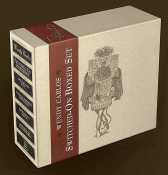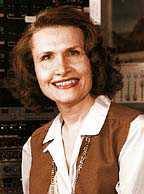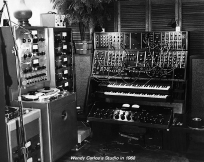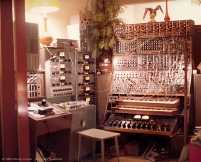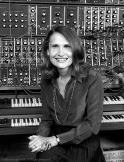On October 26, 1999, electronic composer and technological pioneer Wendy Carlos celebrated
the thirtieth anniversary of her revolutionary
Switched-On Bach (Recognized as the best
selling classical album of all time!) with the release of
the Switched-On Boxed Set (1999, ESD 81422),
a deluxe restoration of her, now out-of-print, analog Bach albums: The albums, she explains, "have been remastered with 20-bit 'Hi-D' technology from the original session tapes, with no re-mixing of any kind. If you notice a few EQ differences, that's because the distortion needed to squash the recording onto the limitations of an LP have been removed." The set also includes intriguing enhanced CD sections and Carlos' meticulously written 200+ page illustrated booklets that share stories about her Moog synthesizers and how she and producer Rachel Elkind recorded the music. After the first album, and as synth technology improved, Carlos tackled the synthesis of more complex orchestral instruments and vocal sounds. Coincidentally, she created a Moog plus vocoder version of the choral movement of Beethoven's Ninth Symphony right as director Stanley Kubrick began work on Clockwork Orange (1971, East Side Digital). Carlos also contributed the chilling electronic score for Kubrick's The Shining (1980); the futuristic music for Disney's Tron; and the score for Woundings, a 1998 British anti-war movie. Her solo albums include Sonic Seasonings/Land of the Midnight Sun, an electronic tone poem that is often cited on "essential New Age recordings" lists (newly mastered from East Side Digital); a spoof of Prokofiev's Peter and the Wolf (1988, CBS/Sony MK 44567, currently out of print); Switched-On Bach 2000 (1992, Telarc) using MIDI; Digital Moonscapes (1983, CBS / re-released in 2000, ESD 81542), which used her digital recreation of a symphony; Beauty In the Beast (1987, Audion / re-released in 2000, ESD 81552), which casts off the limits of the equal tempered scale; and the dark and brooding Tales Of Heaven & Hell (1998, ESD). Carlos continues to push the envelope of every technological advance, and she constantly investigates the compositional possibilities of alternate tunings. An important, albeit tedious, part of Carlos' life was securing the rights to all her works back from CBS, Audion, and other labels, and restoring the master tapes. Eventually, these out-of-print albums will be available through East Side Digital. Her website, www.wendycarlos.com is one of the most fascinating on the internet. A complete cyber tour of her album descriptions, technical notes, anecdotes (including remembrances of director Stanley Kubrick), eclipse photos, sketches, innovative globe projections, and "kritter corner" can take hours. So many interests. How does she do it all, and find brainspace for her legendary pun-a-thons? "Before I die, I want to find out what lies beyond all these horizons," she says. "And I'm doing it for the best reason in the world: I'm curious."
Carol Wright: Congratulations on putting the set to bed. Wendy Carlos: It's done! This was such a big project for one that is not wholly new material. I'm pleased it came out so well. I'm old enough to remember Pre-Switched. Electronic music was like some obnoxious mating of a catfight and a garbage compactor. Or electronic music meant the eerie Theremin, the wooo-oooo-woo sound they used on cheesy invader-from-Mars movies. Do you have a sense that you took electronic music to where it could be accepted? WENDY: That's what people tell me. I was lucky enough to be at the Columbia-Princeton Electronic Music Center, where Vladimir Ussachevsky and Otto Luening were teaching. I thought what ought to be done was obvious, to use the new technology for appealing music you could really listen to. Why wasn't it being used for anything but the academy approved "ugly" music? You know, the more avant-garde than thou-ers, atonal, or formally tedious serial, twelve-tone straitjacket. My beloved field was decimated, turned into something quite hateful. It's like we had to start all over again. C-major, C-major, C-major! Let's move on to D-major, already. Anyway, it's nice to have demonstrated -- which was all it was -- that the medium was far more flexible and capable than one might have been aware. That's all Switched-On Bach was meant to be. I was there with the rest in saying, "this electronic music gives me a headache." But the mainstream was also numb to the classics, so you brought them an appreciation of Bach as well. WENDY: I was certainly not about any revival of Bach. It was just lovely music, eminently suited for this stage of the development of Bob Moog's new synthesizer. A perfect match then? WENDY: Now, we'd say so. But then, people laughed at us, saying that interest would soon peter out. Then they came back and said, "Ah, we got it! We always knew you could do it!"
By the way, great job on your website. I've spent hours there and have just scratched the surface. It took an hour just to read about your fuzzy critters. WENDY: I love animals -- I have three Siamese cats and a terrier -- and would love to have a horsey, but it wouldn't be happy in Manhattan. Many modern composers starting creating post-MIDI. They were given their sounds on a silver platter. I'm not sure they all really appreciate where... WENDY: None of us really know what giants' shoulders we stand on. Should we have a responsibility to know what and who came before us? It's not necessary to play or compose music, but then, I look back to Bob Moog and the others who came before me, and I'm grateful. I was lucky enough to be there when electronic music was still an infant, and I was there to help it take some of the steps needed to mature into a real medium. There were so many stages necessary for the creation of electronic music: the Ondes Martinot and the Theremin -- many devices, actually, from over a hundred years ago. The original synthesizer was built by RCA, and the second of only two models was located at the Columbia lab. That's where Bob Moog got the name for his device. He combined many different modules in one cabinet, and this collection of tools is what Bob called the synthesizer. Could you give an idea of what it took back then to create just one measure of Bach's music? No, to create a chord. No, a note. I guess you'd have to start with whether it was a violin sound or a harpsichord. Where did you start? WENDY: With Bach. It's easy if you're doing someone else's music, so I went and bought a score. What a concept! And Bach composed his great works during a period that had just begun to be aware of the orchestral instruments, so the music wasn't tied closely to the orchestration. I wouldn't have wanted to go tampering with Mozart or Haydn. But Bach was a two-edged sword. I didn't have to work out any notes. BUT, for me as a composer, it was almost a disaster. I got identified with Bach like Nimoy was with Star-Trek's Spock! Hardware-wise, we had to use multi-tracking recorded on one eight-track machine, fairly racy hardware for its day. And since I didn't have much money, I built my own unit. Then I got the Moog and worked with Bob to make a prototype of a touch-sensitive keyboard. Can you believe, the standard keyboard was not touch-sensitive until the late 1970s!? So, now I had a keyboard that could make the notes come alive. So I worked with some friends trying jazz. We tried rock n' roll. And I tried my own compositions, which were not the ugly forms you referred to earlier. However, the music that seemed most likely to turn into a record was Bach. So Rachel Elkind, my producer, and I started with the two-part "Invention in F."
For many more great pictures of Wendy Carlos' studio throughout the years (as well as other related photos of Wendy, her equipment, her artwork, and even her pets), check out her website at www.WendyCarlos.com. How did you make the individual sounds? WENDY: There wasn't much to making the sounds
itself. I studied physics and music and knew a lot about the
basics of timbre and acoustics. The Moog wasn't all that
elaborate. There were a couple of oscillators, and you
adjusted them to track the octaves. You would pick a wave
shape from the four available: sine, triangle, pulse wave,
and sawtooth. There was a white noise source, and a filter
to reduce the high end of the wave, to make it sound more
mellow, to add resonance, or take out the bottom. Then there
were envelopers that came from Ussachevsky's ideas: attack
time, decay, sustain, and release. Set the thing to ramp up
at some rate: slow for an organ or fast for a plucked
string. Make it decay immediately for a harpsichord, or
sustain for a piano. Have the final release time based on
the need, short and dry, or longer for the vibrating body of
a cello or drum. Easy.
Right.
Piece-a-cake. WENDY: It's not all schematic diagrams and such. You
could hear the adjustments. You'd dial up something, listen
to it, and keep hitting the note over and over, letting your
inner ear guide you while adjusting with the dials. So we
would work up a sound and then record it. You try this, try
that. The musicians working in the medium now have these
advanced tools, but they should not be stuck using only MIDI
and prerecorded sounds. If they want to learn how the medium
ticks, they should open the hood, get inside, and get dirty.
And they'll be grateful for every learning, for every
discovery. It's wonderful, but damn, you have to have the
motivation. And the curiosity! So, you fiddled with
dials until you got a violin. (Hey, I made a pun!) How
different from today's MIDI samples. You want a Strad? or a
Guarnari? WENDY: Well, canned sound to a musician is like
clip art is to the artist. The only way you can do anything
of any value in art is by knowing how to do it yourself. Of
course that's not the mentality right now. My opinion is
very unpopular, and many people consider me an elitist. Is
it so bad to keep standards up? We expect an Olympic athlete
to be disciplined, to eat right, to work out daily, and to
have a great coach so they can be as good as they can be. So
why not have standards for artists? With the modern keyboards, there's a democratization
of music, just as in the past, every kid had to take piano
lessons. This is wonderful in a way, but how many went on to
play as a soloist? In the case of composers, have the
technological advances increased the output of masterpieces?
I don't think so. I don't claim to write masterpieces, but I
don't stop until it's the best I can do. The musicians working in the medium now have these
advanced tools, but they should not be stuck using only MIDI
and prerecorded sounds. If they want to learn how the medium
ticks, they should open the hood, get inside, and get dirty.
And they'll be grateful for every learning, for every
discovery. It's wonderful, but damn, you have to have the
motivation. And the curiosity! So, you did create
your own trumpet, organ, and violin . . . and then . .
. WENDY: Tempo. Rachel helped me nail the tempo by
putting down a click track. If, when I put the notes down
against it, it sounded too fast -- too bad! -- I did it over
again. Then we'd want a ritardando. Who thinks of a ritard
when you're making a click track? So we would adjust for
that. And that keyboard? Amazingly clunky with all those
touch-sensing mechanical gadgets in it. I had to clatter
away slower than actual speed; you could never play faster
than moderato. Sixteenth notes at a good clip? Forget
it! In the end, it was a lot of bookkeeping, and not as
intuitive as a modern keyboard. I wish I had [Mark of the Unicorn] Digital
Performer back then. But, nope. Wonder if I could work
with it again? Maybe it's like a bicycle and you don't
forget. But, using today's
technology, the Bach wouldn't have been as
special. WENDY: I suppose you're right. If you're a
pioneer, you get to have the arrows in the ass, I guess. This Portrait is a good candidate for the best photo of me. Photographer Vernon L. Smith is also a first-rate jazz trumpeter, and we got along famously from the first time we met.... It was taken sometime in the Fall of 1980, for promotional and magazine use... -- Wendy Carlos, How much could you
record in one take? WENDY: If the tonal quality didn't change much
over the phrase, you could get down a measure or two. The
Moog was very unstable and would go out of tune constantly.
You would play a phrase, back up, and check. Retune and
continue. To create a chord, you'd play the second line,
then the third. With counter point, you'd play the melodies
that wove together. Eventually, we got all the parts to make
the piece. Hearing Switched-On-Bach probably moved me as much as
watching those very first television images of the moon
landing. Hearing the didgeridoo for the first time also had
a mindbending impact on me. Where are the new frontiers of
sound? WENDY: So, Carol, how many other moon landings,
didgeridoos, or peak experiences does it take for you to be
equally impressed? What about all the best life experiences
in between? We always remember our first exposures, I guess
that's only human. And it's easier to be impressed when
we're young. The field of electronic music is still able to move,
but with less noticeable refinements. But there is plenty of
room for improvements: We still don't have a general-purpose
instrument. The closest I have is the Synergy,
on which I made Beauty In the Beast, and the Kurzweill K2000/2500, which is
flexible and very clean sounding. But I'm so impatient. As an insider, I feel like the
developers have been smoking far too many joints. "Oh, wow,
man. Look at that. There's a universe of sounds in there!"
No, there is not! Wake up! Let's get going, already. At some
point in your life, you fatigue out and realize it just may
not happen. They aren't moving, and I can't make it happen
all by myself. However, making music is not dependent on
that, so I keep composing. Do you think the
re-release of this set will box you back to Bach? or will it
give you fresh platform as a composer? WENDY: I'm aware that the knife will be there with
both edges. I am a composer, so I hope that the focus of
this interview is not "Wendy Carlos, the performer of Bach
on the synthesizer." This was my payment of dues (which
unfortunately never stopped) to show that I had an ability
with the new media to make real music. I thought I then
would be allowed to perform and record my own music, but I
got locked in with Bach. People hate to see any of us, once
stereotyped into one egg-compartment, overflow into several
other compartments. I guess you get only one cell per
customer. You were asking about new sounds; you probably
haven't heard Tales Of Heaven & Hell. [Note: Carol has since listened
and written a
thoughtful, enthusiastic review,
and offered an example of a new art-form, with her jocular
Poem-Review.] It's
the scariest recording that's been created in a long time,
and I'll bet it's quite different than anything you've ever
heard. Are they "breakthrough sounds"? No. But they are
different and they have refinements and they are very
musically handled. Why do we always search for something we've never
heard before? If your pursuit is not to be as good as you
can be, but an obsession to be new, then you've thrown away
your art. Art has to be stable to some extent. The medium
has matured and is capable of great depth and expression,
more than the SOB technology could ever hope to be. Now that
the technology has matured, people should try to make the
great music, the meaty music, and not cave in to every
commercial cliché. But that's just me talking. For those who just
consider music as just a career, this is probably bad
advice. Forget I said it. But if you're doing it as an
artist, then by all means, aim for the good. Think you'll ever
run out of ideas? WENDY: Hardly. The whole palette of life is
wonderful. I used to worry about running out of ideas, and
now I worry I can touch only a tiny fraction of what I want
to do. In music, alternative tunings are an option. It's
like throwing away the straight jacket of the twelve-tone,
equal tempered scale. But people can get stuck simply
discovering the new scales, and then write no good music for
it. The whole palette of life is
wonderful. I used to worry about running out of ideas, and
now I worry I can touch only a tiny fraction of what I want
to do. Now as I get older, I can look back. I realize that I
was a young whippersnapper to think that I could be a
performer when I hadn't paid the dues. It's embarrassing
that my Bach records are placed alongside Glenn Gould and
Horowitz. I don't think that I'm a particularly great
performer even of my own music, but with the Digital
Performer, I am able to refine things in a sensitive way,
keep the spirit that I first had and still make it polished.
I am quite satisfied with Tales Of Heaven & Hell; it's
probably the best performing I've done on an album. Every
note and sound is "just so." When listening to all the Bach pieces again, I was
aware of the fluffs, wrong tempos, and the passages the Moog
just couldn't quite negotiate. But I was surprised that most
of them have such spirit. I marvel that I had such tenacity
back then; the way we worked was so tedious, it should have
removed all traces of spontaneity. So, I'm perfectly happy to set my Bach beside my most
recent works. Altogether, it's part of the fulcrum of how an
artist's whole life should be seen. It's a little surreal
seeing your own life as having periods -- early, middle, and
late -- but there was an innocence back then. It really was,
as you mentioned, the stuff of the first moon landing, of
leaving those first footprints in the dust. [ Site Map ] [ About Us ] [ Contact Us ] Synthmuseum.com | ||||||||||||||||||||||||||||||||||||||||||||||||||||||||||||||||||||||||||||||||||||||||||||||||

